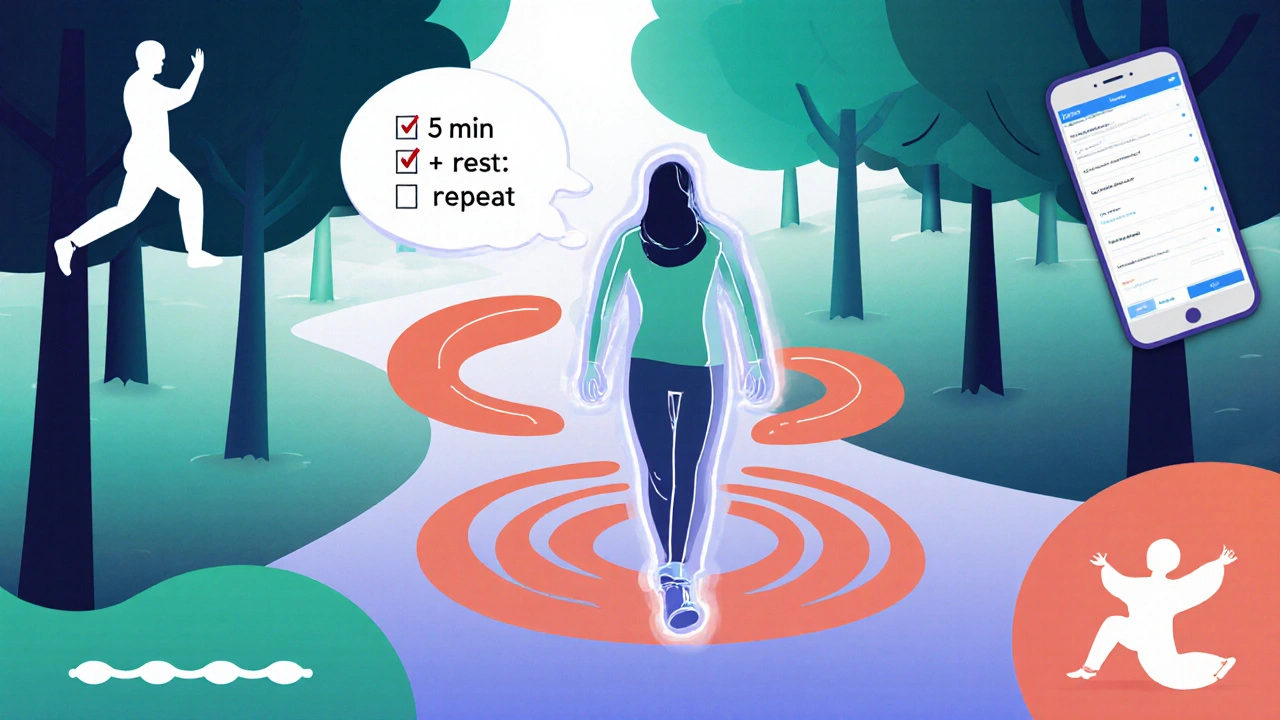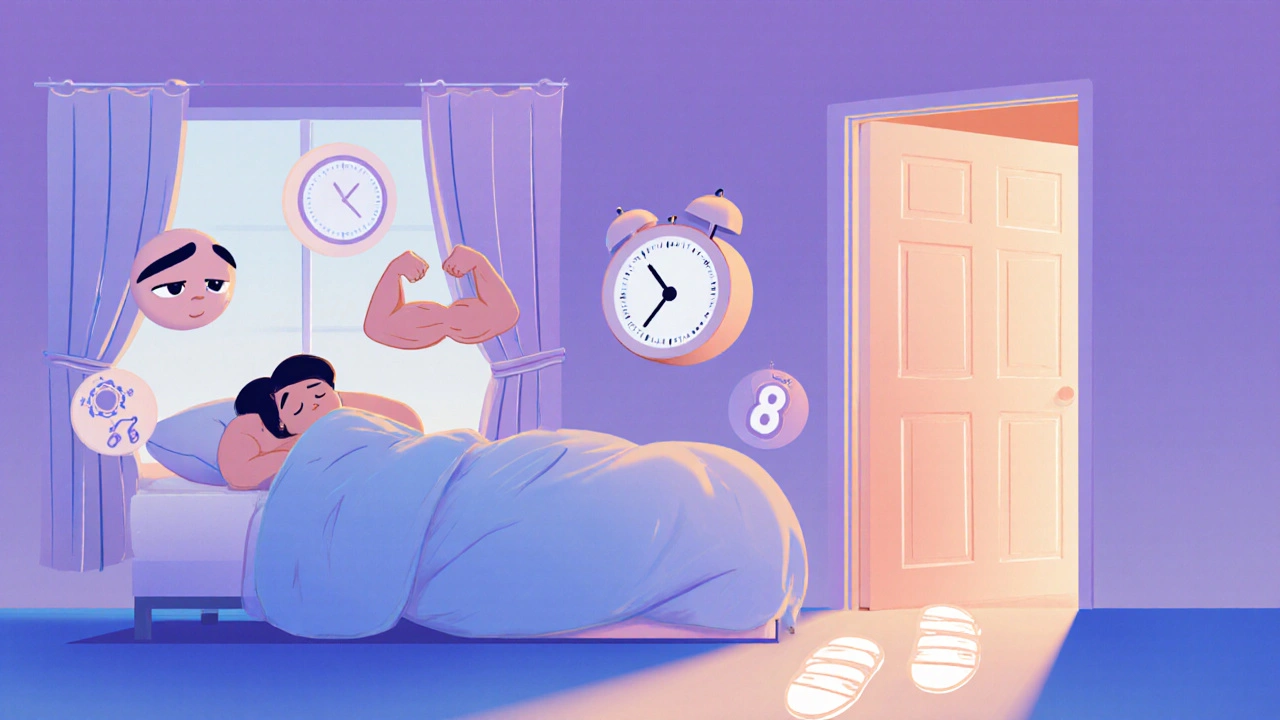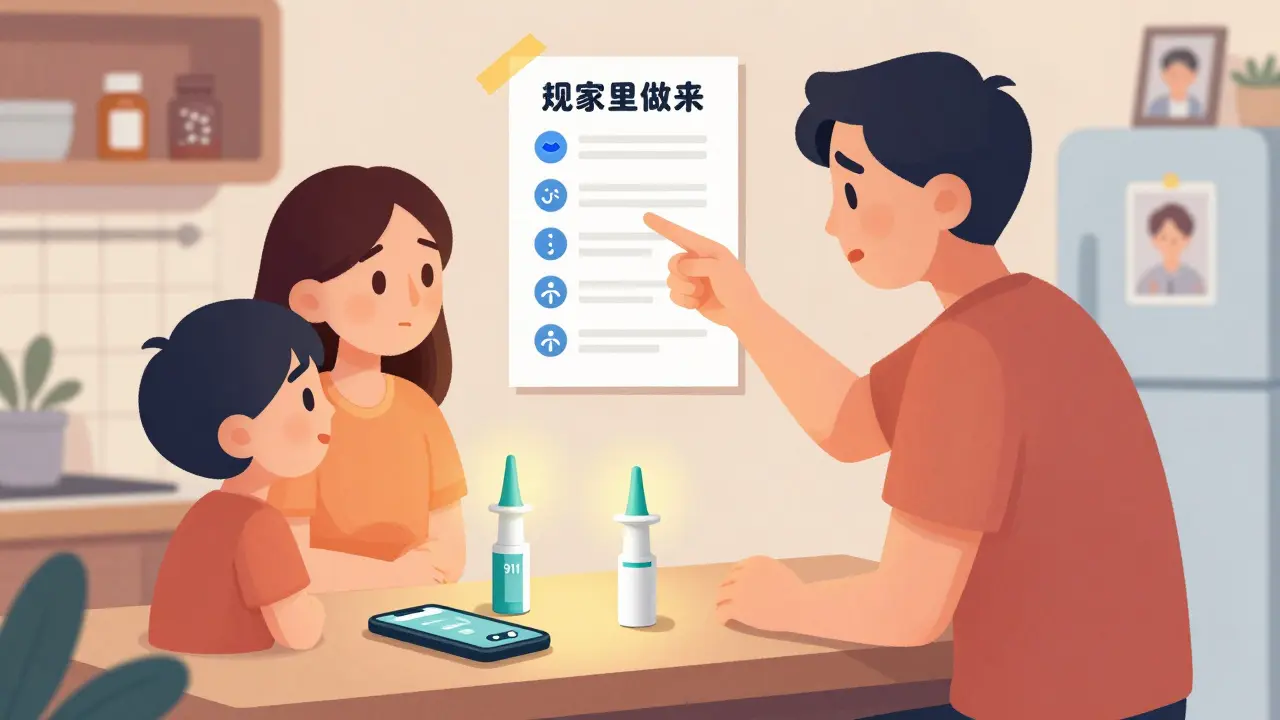Living with fibromyalgia isn’t about finding a cure-it’s about learning how to live well despite the pain.
You wake up tired, even after eight hours of sleep. Your muscles ache all over, like you’ve been hit by a truck, but there’s no injury to explain it. Some days, you can barely get out of bed. Other days, you push through and pay for it later. This is the reality for about 4 million Americans with fibromyalgia-and millions more worldwide. It’s not just "feeling sore." It’s a real, measurable condition that changes how your nervous system processes pain. The good news? You don’t have to wait for a miracle drug to feel better. The most effective strategies are things you can start today: movement, mindset, and consistency.
Medications help, but they’re not the whole story
Three drugs are FDA-approved specifically for fibromyalgia: pregabalin (Lyrica), duloxetine (Cymbalta), and milnacipran (Savella). They work by calming overactive nerves, and for many people, they reduce pain by 30-40%. But here’s what most doctors won’t tell you upfront: these meds don’t work for everyone. About 25% of patients get half their pain relief from them, according to research. Side effects are common too-dizziness, weight gain, nausea. One person on Reddit said they tried four antidepressants over two years and ended up feeling worse than before.
Pregabalin might lower your pain score by 1.2 to 1.8 points on a 10-point scale, but if you’re dizzy every morning or feel like you’re walking through syrup, is it worth it? That’s why experts like Dr. Daniel Clauw from the University of Michigan say: "The cornerstone of treatment is non-pharmacological approaches. Medications are adjuncts." Think of them as tools, not solutions.
Exercise isn’t optional-it’s medicine
The idea of exercising when you’re in constant pain sounds impossible. But here’s the truth: avoiding movement makes fibromyalgia worse. Studies show that people who stick with moderate aerobic exercise-like walking, swimming, or cycling-see pain scores drop by 20-30% after just 12 weeks.
You don’t need to run a marathon. Start small: 5 to 10 minutes of walking, two or three times a week. That’s it. When your body adjusts, slowly add five more minutes each week. The goal? 30 minutes, five days a week. It sounds simple, but it’s powerful. A 2017 Cochrane review found aerobic exercise reduced pain more than strength training or no exercise at all.
Swimming is especially helpful for people in Australia, where pools are widely available and the water supports your joints. One woman on MyFibroTeam said after six months of tai chi twice a week, her pain dropped from 8/10 to 4/10-and she cut her medication in half.
Expect setbacks. Around 45% of people feel worse during the first two to four weeks. That’s normal. Your body is relearning how to move without triggering pain signals. Pace yourself. Rest when you need to. Keep going.

Cognitive behavioral therapy (CBT) reprograms how you experience pain
Pain isn’t just in your muscles-it’s in your brain. Fibromyalgia is linked to central sensitization, where your nervous system becomes hypersensitive. CBT doesn’t tell you to "think positive." It teaches you how to break the cycle of pain, fear, and avoidance.
In an 8- to 12-week program, you learn skills like:
- Recognizing and challenging catastrophic thoughts ("I’ll never get better")
- Planning activity around energy levels, not pain levels
- Using relaxation techniques to calm your nervous system
Research shows CBT reduces pain intensity by 25-30%. That’s better than most drugs. People on Reddit give CBT 4.2 out of 5 stars, especially praising tools for managing flare-ups. The downside? Finding a therapist covered by insurance is hard. About 42% of patients struggle to get CBT approved.
If you can’t find a therapist, try online programs. Apps like Pain Toolkit or This Way Up offer structured CBT modules you can do at home. They’re not perfect, but they’re better than nothing.
Complementary therapies: what actually works
Over half of people with fibromyalgia use complementary approaches. Not all of them help. Here’s what the evidence says:
- Tai chi: Practiced twice a week for 12 weeks, it improves pain and function. It’s gentle, mindful, and builds strength slowly.
- Yoga: 32% of patients use it. Look for gentle or restorative styles-avoid hot yoga or intense flows.
- Massage therapy: Helps with muscle tension and sleep. One study showed a 22% improvement in quality of life after 12 weekly sessions.
- Acupuncture: Some people swear by it, but high-quality studies show it’s no better than sham acupuncture. It might help with relaxation, but don’t expect pain relief.
- Myofascial release: A type of deep tissue work that can ease tightness. Best done by a trained physiotherapist.
Don’t waste money on unproven supplements. There’s no magic pill. Magnesium, vitamin D, or CBD might help some people feel calmer, but they don’t fix the root issue.
Living with flare-ups: pacing is everything
Flare-ups happen. About 89% of people with fibromyalgia experience them. They’re triggered by stress, poor sleep, weather changes, or overdoing it.
The key isn’t to avoid activity-it’s to manage it. This is called pacing. Instead of doing everything on a good day, break tasks into small chunks. Do 15 minutes of cleaning, then rest. Then do another 15. Use a timer. Keep a daily log of what you do and how you feel. You’ll start to see patterns.
One woman in Brisbane told me she stopped trying to "get through" her chores and started scheduling "energy breaks." She now does laundry in two 10-minute sessions instead of one 30-minute marathon. It’s not glamorous, but it keeps her out of bed.
Building a support system you can rely on
Fibromyalgia is invisible. Friends and family might say, "But you look fine." That hurts. You need people who understand.
Online communities like MyFibroTeam and FibroCenter have thousands of active members. They share tips on insurance battles, doctor recommendations, and how to explain your condition to your boss. The Arthritis Foundation runs free exercise programs in 47 U.S. states and has local chapters in Australia too.
Don’t go it alone. Join a group. Talk to someone who gets it. You’re not weak for needing support-you’re smart.
What’s on the horizon?
Research is moving fast. In 2023, the NIH spent $18.7 million studying fibromyalgia, focusing on brain imaging and new non-opioid drugs. One experimental drug, NBI-1117568, showed 35% pain reduction in early trials. A blood test called FM/a was approved by the FDA in 2022, but major medical groups still don’t accept it as diagnostic.
For now, the best tools you have are the ones already proven: movement, therapy, and patience. The goal isn’t to be pain-free. It’s to live fully despite the pain.
Where to start today
Don’t wait for the perfect plan. Start with one thing.
- Take a 10-minute walk this week. No pressure to do more.
- Download a free CBT app like Pain Toolkit or This Way Up.
- Write down three things that make your pain worse-and one thing that helps.
- Reach out to FibroCenter or the Arthritis Foundation for local resources.
Progress isn’t linear. Some days will be hard. But every small step adds up. You’re not broken. You’re adapting. And that takes courage.
Can fibromyalgia go away on its own?
No, fibromyalgia doesn’t go away on its own. It’s a chronic condition, meaning it lasts for years or a lifetime. But symptoms can improve significantly with the right combination of exercise, therapy, and self-management. Many people learn to reduce flare-ups and live full, active lives-even if they still feel some pain.
Is fibromyalgia just "in my head"?
No. Fibromyalgia is a real neurological condition. Brain scans show differences in how people with fibromyalgia process pain signals. It’s not psychological-it’s physiological. The pain is real, even if there’s no visible injury. The term "in your head" is outdated and harmful. Your symptoms deserve validation, not dismissal.
What’s the best exercise for fibromyalgia?
Moderate aerobic exercise is the most effective. Walking, swimming, cycling, and tai chi are top choices. Start slow-5 to 10 minutes two or three times a week-and build up gradually. Avoid high-impact activities like running or jumping, which can trigger flares. Consistency matters more than intensity.
Do I have to stop working if I have fibromyalgia?
Most people with fibromyalgia continue working, especially with accommodations. Adjustments like flexible hours, sitting desks, or short breaks can make a big difference. If symptoms are severe, you may qualify for disability support. Talk to your doctor about what’s reasonable for your body. You don’t have to choose between work and health-you can find a balance.
Why do some doctors not believe in fibromyalgia?
Some doctors were trained before fibromyalgia was widely understood. It doesn’t show up on X-rays or blood tests, which made it easy to dismiss. But since the 1990s, research has confirmed it as a legitimate neurological disorder. The American College of Rheumatology and the CDC both recognize it. If your doctor doesn’t take it seriously, consider finding one who does. Your pain matters.
How long does it take to see results from lifestyle changes?
Most people notice small improvements within 4 to 8 weeks of consistent exercise or CBT. Major changes-like reduced pain intensity or better sleep-usually take 3 to 6 months. It’s not fast, but it’s lasting. The key is sticking with it, even on bad days. Progress isn’t always visible, but it’s happening.
Are there any foods that make fibromyalgia worse?
There’s no universal fibromyalgia diet, but some people find that sugar, processed foods, caffeine, or alcohol worsen fatigue and pain. Keeping a food and symptom journal for a few weeks can help you spot your personal triggers. Focus on whole foods, hydration, and regular meals to stabilize energy. Avoid extreme diets-they often do more harm than good.
Can stress cause fibromyalgia?
Stress doesn’t cause fibromyalgia, but it can trigger it in people who are genetically predisposed. Trauma, illness, or long-term emotional strain can activate the nervous system changes that lead to widespread pain. Managing stress through CBT, mindfulness, or gentle movement is one of the most effective ways to reduce flares.







Koltin Hammer
November 17, 2025 AT 07:27Man, I wish I'd known about pacing five years ago. I used to think if I just pushed harder, the pain would disappear. Spoiler: it didn't. Now I break everything into 10-minute chunks. Laundry? Two rounds. Cooking? One dish at a time. I even set a timer for bathroom breaks. It sounds ridiculous, but I haven't been bedridden in six months. The trick isn't doing less-it's doing it smarter.
kanishetti anusha
November 18, 2025 AT 10:06I started with just 5 minutes of walking every other day. No goals. No tracker. Just put on shoes and step outside. Some days I only made it to the mailbox. Other days, I walked around the block. After three months, I could do 20 minutes without wanting to cry. It’s not about fitness-it’s about teaching your body you’re safe to move.
Willie Randle
November 18, 2025 AT 23:07CBT isn't a magic pill, but it's the closest thing we have. I did a 12-week online program through This Way Up. It didn't make the pain vanish, but it stopped me from spiraling every time it flared. I used to think, 'This is it-I'm ruined.' Now I think, 'This is a wave. It'll pass.' That shift? Priceless. And it cost me $0.
Liam Dunne
November 20, 2025 AT 17:55Swimming saved me. Not because it’s high-tech or fancy, but because the water holds you. No gravity. No pressure. Just slow, rhythmic movement. I started with 10 minutes twice a week. Now I do 45. My pain score dropped from 8 to 4.5. And no meds. Just water, time, and patience. If you can get to a pool, try it. Even if it feels stupid at first.
Vera Wayne
November 22, 2025 AT 17:55I tried acupuncture. I cried after the first session-not from pain, but from relief. My therapist said it was placebo. Maybe. But if your nervous system calms down, does it matter why? I still do it every two weeks. It’s not a cure, but it’s a pause button. And sometimes, that’s enough.
Eric Gregorich
November 24, 2025 AT 11:26Let’s be real-fibromyalgia isn’t a disease, it’s a system failure. Your nervous system got hijacked by trauma, stress, or some invisible glitch in your biology, and now it’s stuck in red alert mode. The drugs? They’re like putting duct tape on a leaking dam. They slow the flow, but they don’t fix the crack. Exercise? CBT? Pacing? Those are the real repair crews. They don’t promise perfection-they promise adaptation. And in a world that glorifies ‘overcoming,’ adaptation is the quietest, most radical act of rebellion.
Phil Best
November 26, 2025 AT 02:23Oh, so now we’re supposed to be grateful that we’re not being told to ‘just get over it’? Progress! Next they’ll hand out medals for not being dismissed by your doctor. Look, I get it. Movement helps. CBT helps. But let’s not pretend this is a wellness blog. This is a chronic, debilitating condition that makes you feel like a ghost in your own body. And yeah, some of us still can’t afford therapy, can’t walk to the mailbox, and have to explain to our boss why we ‘look fine’ but can’t type for more than 20 minutes. So don’t pat yourself on the back for surviving. Just keep going.
Patrick Merk
November 26, 2025 AT 10:26My cousin in Cork did tai chi for six months and went from barely leaving the house to leading a weekly group. She said the slow movements made her feel like she was finally listening to her body instead of fighting it. I started last month-just 15 minutes a day in my living room. I don’t know if it’s working yet. But I’m not screaming at the ceiling every morning anymore. That’s something.
Parv Trivedi
November 26, 2025 AT 14:10In India, many people with chronic pain use yoga and pranayama. I know someone who reduced her pain by practicing deep breathing for 10 minutes before bed. No fancy apps. No expensive therapists. Just calm breaths. It’s simple, but it works. I think we forget that healing doesn’t always need technology. Sometimes, it just needs stillness.
Connor Moizer
November 28, 2025 AT 12:37Stop glorifying ‘small steps.’ If you’re in so much pain you can’t tie your shoes, telling you to ‘walk 10 minutes’ is like telling a drowning person to ‘tread water.’ Some of us are fighting just to get out of bed. Don’t act like everyone has the same energy, same access, same privilege. Your ‘progress’ isn’t my reality. And if your advice doesn’t account for that, it’s not help-it’s gaslighting with a smiley face.
Rodney Keats
November 28, 2025 AT 13:59Of course the FDA approved a blood test. They just don’t want you to know it’s been sitting on a shelf since 2022 because insurance won’t cover it. Welcome to American healthcare-where science exists, but only if you can pay for it.
Laura-Jade Vaughan
November 28, 2025 AT 18:14OMG I just started using Pain Toolkit and it’s a GAME CHANGER 😭 I’ve been journaling my energy levels and it’s like… I can actually see patterns?! Like, I didn’t realize my pain spiked every time I ate gluten?!!?? I’m crying happy tears!! 🥹✨ #FibroWarrior #PainIsRealButSoAmI
roy bradfield
November 29, 2025 AT 20:21Let’s talk about the real elephant in the room-why are we being sold hope like it’s a supplement? The pharmaceutical companies fund the studies. The ‘experts’ get paid to say movement works. But nobody’s asking why this disease exploded in the last 20 years. Why now? Why mostly women? Why does it mirror the symptoms of chronic stress and trauma? We’re being told to adapt, not investigate. And that’s not healing. That’s surrender dressed in yoga pants.